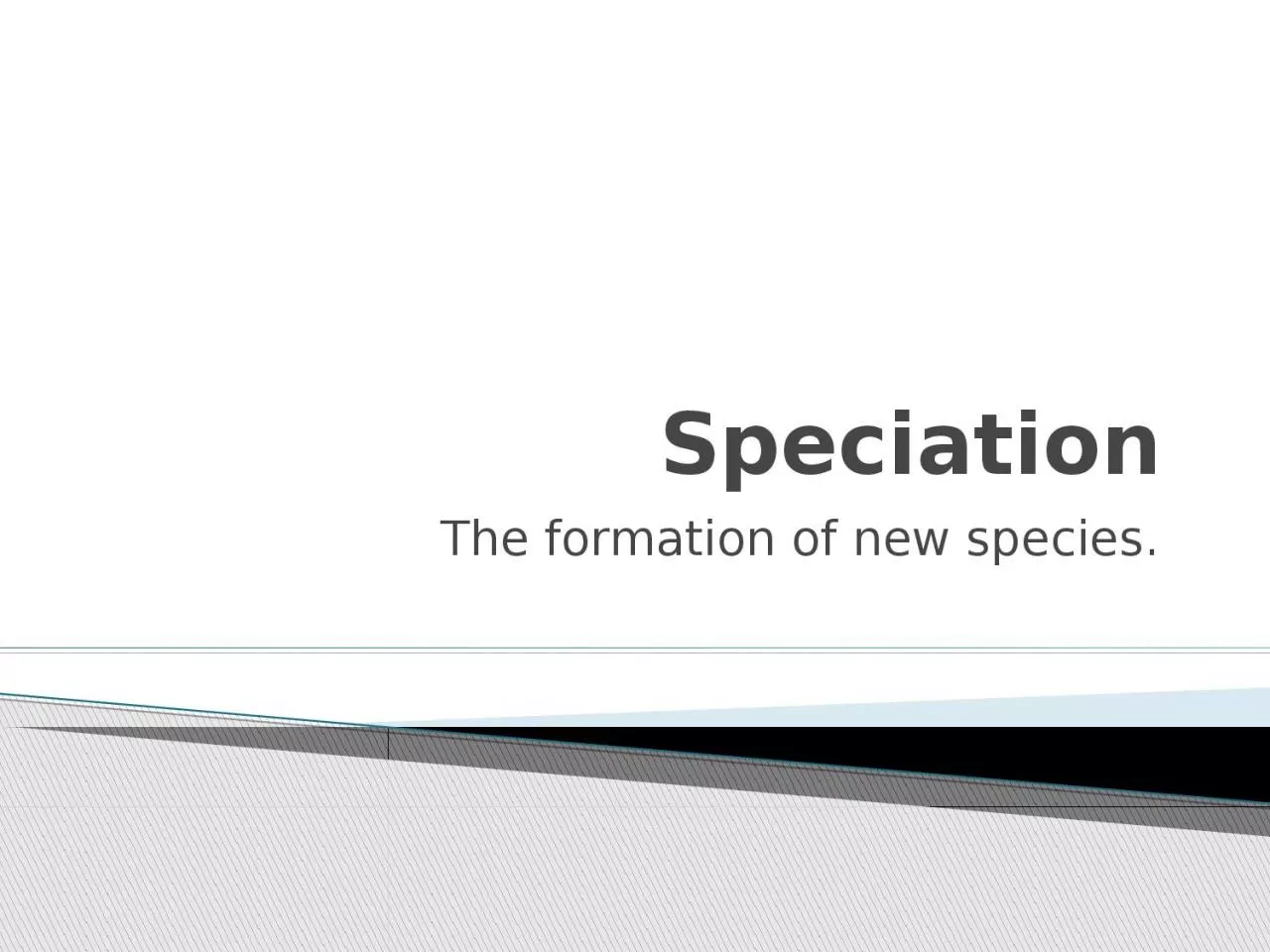

In evolutionary terms a species is a group of populations whose members have the potential to interbreed in nature and produce viable fertile offspring they do not breed successfully with other ID: 933403
Download Presentation The PPT/PDF document "Speciation The formation of new species." is the property of its rightful owner. Permission is granted to download and print the materials on this web site for personal, non-commercial use only, and to display it on your personal computer provided you do not modify the materials and that you retain all copyright notices contained in the materials. By downloading content from our website, you accept the terms of this agreement.
Slide1
Speciation
The formation of new species.
Slide2In evolutionary terms a
species
is a group of populations whose members have the potential to interbreed in nature and produce viable, fertile offspring; they do not breed successfully with other populations
The Biological Species Concept
Slide3Reproductive isolation
is the existence of biological factors (barriers) that impede two species from producing viable, fertile offspring
Reproductive isolation can be classified by whether factors act before or after fertilization
Reproductive Isolation
Slide4Prezygotic
barriers
block fertilization from occurring by:Impeding different species from attempting to mate – courtship rituals, timing, and/or habitat
Preventing the successful completion of
mating - Morphological differences can prevent successful mating
Hindering fertilization if mating is
successful - Sperm of one species may not be able to fertilize eggs of another species
Slide5Postzygotic barriers
prevent the hybrid zygote from developing into a viable, fertile adult
:Reduced hybrid viability - Genes of the different parent species may interact and impair the hybrid’s development
Reduced hybrid
fertility - Even if hybrids are vigorous, they may be sterile
Hybrid
breakdown - Some first-generation hybrids are fertile, but when they mate with another species or with either parent species, offspring of the next generation are feeble or sterile
Slide6Fig. 24-4a
Habitat Isolation
Temporal Isolation
Prezygotic barriers
Behavioral Isolation
Mating
attempt
Mechanical Isolation
(f)
(e)
(c)
(a)
(b)
(d)
Individuals
of
different
species
Slide7Fig. 24-4i
Prezygotic barriers
Gametic Isolation
Fertilization
Reduced Hybrid Viability
Postzygotic barriers
Reduced Hybrid Fertility
Hybrid Breakdown
Viable,
fertile
offspring
(g)
(h)
(i)
(j)
(l)
(k)
Slide8Reproductive barriers may lead to speciation.
Speciation
, the origin of new species, is at the focal point of evolutionary theory Speciation
Slide9Fig. 24-5
(a) Allopatric speciation
(b) Sympatric speciation
Speciation can occur in two ways:
Allopatric Speciation
Sympatric Speciation
Slide10In
allopatric speciation
, gene flow is interrupted or reduced when a population is divided into geographically isolated subpopulationsAllopatric (“Other Country”) Speciation
Slide11The definition of
barrier
depends on the ability of a population to disperseSeparate populations may evolve independently through mutation, natural selection, and genetic drift
The Process of Allopatric Speciation
Slide12Fig. 24-6
A. harrisi
A. leucurus
Allopatric Speciation of antelope squirrels on opposite rims of the Grand Canyon.
Slide13In
sympatric speciation
, speciation takes place in geographically overlapping populationsSympatric (“Same Country”) Speciation
Slide14Polyploidy
is the presence of extra sets of chromosomes due to accidents during cell
divisionPolyploidy is much more common in plants than in animals
Polyploidy
2
n
= 6
4
n
= 12
Failure of cell
division after
chromosome
duplication gives
rise to tetraploid
tissue.
2
n
Gametesproducedare diploid.
.
4n
Offspring withtetraploidkaryotypes may
be viable and
fertile.
Slide15Sympatric speciation can also result from the appearance of new ecological niches
For example, the North American maggot fly can live on native hawthorn trees as well as more recently introduced apple trees
Habitat Differentiation
Slide16Sexual selection can drive sympatric speciation
Sexual selection for mates of different colors has likely contributed to the speciation in cichlid fish in Lake Victoria
Sexual Selection
EXPERIMENT
Normal light
Monochromatic
orange light
P.
pundamilia
P. nyererei
Slide17In allopatric speciation, geographic isolation restricts gene flow between populations
Reproductive isolation may then arise by natural selection, genetic drift, or sexual selection in the isolated populations
Even if contact is restored between populations, interbreeding is prevented In sympatric speciation, a reproductive barrier isolates a subset of a population without geographic separation from the parent species
Sympatric speciation can result from polyploidy, natural selection, or sexual selection
Allopatric and Sympatric Speciation:
A Review
Slide18The fossil record includes examples of species that appear suddenly, persist essentially unchanged for some time, and then apparently disappear
Niles
Eldredge and Stephen Jay Gould coined the term
punctuated equilibrium
to describe periods of apparent stasis punctuated by sudden change
The punctuated equilibrium model contrasts with a model of gradual change in a species’
existence - known as
gradualism
. Darwin supported the idea of slow gradual change.
Transition species found in the fossil record are a key component to gradualism.
Patterns
Of Evolution
Slide19Fig. 24-17
(a) Punctuated pattern
(b) Gradual pattern
Time